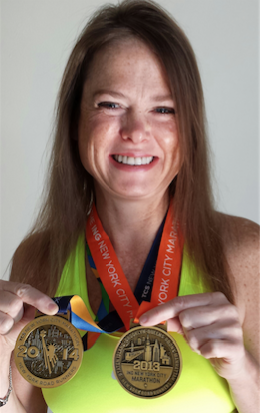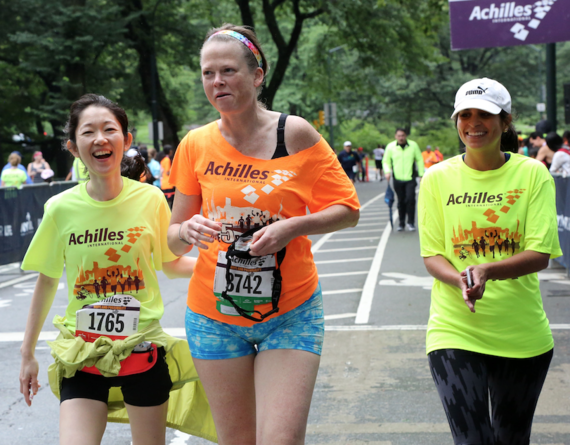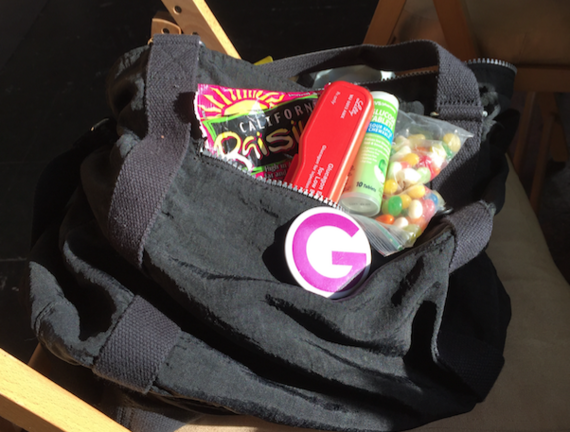Nov. 1 Zoe Heineman is running her third NYC marathon. You can track Zoe during the race by downloading this app. Her bib is #47936.
Zoe's biggest challenge will not be the endurance required, but keeping her blood sugar from dropping dangerously low.
As a fellow Type 1 questions flood my mind: What's it like to run 26 miles when you take insulin? How do you prepare? How do you minimize the risks? What do you carry?
Zoe and hypoglycemia (low blood sugar) are intimately linked. She's turned her passion to educate people about low blood sugar into Ha! It stands for Hypoglycemia Awareness.
Often diseases are represented by celebrities and professional athletes. I find it refreshing when we get to see someone like ourselves doing the remarkable. I talked to Zoe about the upcoming marathon and why there's almost a "conspiracy of silence" around hypoglycemia.
RG: What inspired you to run a marathon?
ZH: Running the NYC marathon had always been on my bucket list. When I was approached by a charity for challenged athletes, I decided it was time. I made a deal with myself. If I got injured during training I would stop.
I started running one mile, then another. I worked up and up. When I got to 22 miles I hit a psychological wall. I knew I could run the marathon. But what if I got hypoglycemia while running? Either 50,000 people would stampede over me, or I'd ruin the race for the guy right behind me. Or both!
That's when I discovered the organization Achilles. They offer guides to run with anyone who has a medical or psychological condition. I ran my first marathon with three guides. They were my peace of mind, and they helped carry some of my diabetes supplies!
RG: What do you carry during the marathon?
ZH: Callus protectors, balm, heat wraps to keep my hands warm, a glucagon emergency kit, back up meter and strips, gels, skittles, seasonal candy corn and glucose tablets. I wear my Dexcom CGM and carry the receiver, wear my Tandem insulin pump and carry extra pump supplies. Before you ask, I wear pants with deep pockets, a shirt with pockets and a fanny pack.
RG: I won't insult you asking how you "control" your blood sugar... but how do you minimize the chances that your blood sugar will go too high and too low?
ZH: Ha, thanks! Despite my best efforts on an ordinary day, thinking about and managing my blood sugar constantly, it's a moving target. I try to start the marathon with my blood sugar around 150 mg/dl (8.3 mmol/l) and stay between 80 mg/dl (4.4 mmol/l) and 150 throughout. If I hit 80, I eat some skittles or glucose bits to bump my blood sugar up. If it gets below 70 mg/dl (3.8 mmol/l) I'll start on gel and just keep running. It works best if I take a gel, which has 15 grams of carbohydrate, every two miles.
When I was diagnosed my endo said the only way I could exercise was if I did it every day, the same time, the same amount, or don't do it. The idea was to make my exercise match the amount of insulin I took rather than adjust my insulin. That's crazy! But it's just as crazy to be on insulin and not be prepared or know what to do if your blood sugar goes too low.
RG: That brings us to the educational resource you launched, Ha!
ZH: Since my diagnosis I've been a diabetes activist. I grew up in Maryland where health insurance didn't cover test strips and syringes so I was part of the group that lobbied for that. Soon after I got diabetes, I left my job as a school teacher and began working in the diabetes industry.
One of my consulting projects was with Biodel, a developer of stable glucagonand ultra-fast acting insulin. We were looking at why people don't use or carry glucagon, the only remedy for severe hypoglycemia. And the costs of severe hypoglycemia. There's no easier risk to mitigate than having people with diabetes be prepared for hypoglycemia. To do that, we need to educate people with diabetes about hypoglycemia and train first responders.
I started Ha! to help someone having hypoglycemia in a public space. First responders like lifeguards, teachers, flight attendants, and police officers aren't taught anything about hypoglycemia. They need to know if someone's blood sugar is too low, they need glucose not insulin. They need a Coke, not a diet Coke. They're not drunk, they just need sugar. The brain starts to shut down quickly when it doesn't have adequate glucose.
Severe hypoglycemia has high costs. People with Type 1 diabetes die unnecessarily from hypoglycemia. People with Type 2 diabetes who use insulin also experience severe hypoglycemia and its consequences. The average cost of an inpatient hospital visit due to hypoglycemia is $17,564. Plus, severe hypoglycemia impacts others. You can have a car crash while you're low and hurt someone else.
Ha! is running a social media campaign, "Show Me Your G" ("G" stands for glucose). The campaign encourages people taking insulin to pin a magenta "G" icon on your bag where you keep your glucose supplies. This makes it easier for others to help if you go low. If you take insulin, or know someone who does, you can purchase a magenta "G" pin on Ebay for only $5. Ha! also offers endocrinologists a mentoring program called Diabuddies. They can pair a new diabetes patient with an old hand.
RG: Does Ha! have corporate sponsorship?
ZH: Not yet. I've approached corporations that I feel should have a vested interest in teaching people about hypoglycemia, like Lilly and Novo Nordisk. They both make insulin and glucagon. But they aren't there yet. I think they don't want to draw attention to the risk of using insulin.
It's remarkable, but even physicians don't teach their patients about hypoglycemia and glucagon. Glucagon is enormously underutilized. Most people who get a script for it are kids. It's their parents who want them to have it. Adults say they don't carry glucagon because who will be there to give it to them, no one knows how to use it, and it's cumbersome to carry.
RG: Have you ever had a severe hypoglycemic event?
ZH: I've had three. One put me in the hospital in Sweden. I was working at a vendor booth at the EASD (European Association for the Study of Diabetes) meeting in Stockholm when I started feeling symptomatic. I was the only person in the booth. For a while all the activity around me distracted me. Finally I realized I needed to go get sugar.
I walked out of the booth, out of the exhibition hall, and to a little convenience store in the convention center. I got a banana and apple juice and got on line. When I reached the clerk I said, "I have diabetes and I'm about to pass out."
The next thing I knew I woke up in an ambulance on my way to the hospital. What's remarkable is my instinct was to go buy apple juice and a banana rather than just get the glucose tablets out of my purse. The hypoglycemia had kidnapped my brain. My common sense was no longer there. And that's precisely why people need to know how to help themselves or someone else who's having severe low blood sugar.
If you want to sponsor Zoe, donations go to Achilles International, click here. Zoe's currently working on a book to share people's stories of hypoglycemia and lessons learned and you'll find her diabetes blog here.
I know November 1st I'll be praying for good weather.

Riva's latest book, Diabetes Dos & How-Tos, is available in print and Kindle, along with her other books, 50 Diabetes Myths That Can Ruin Your Life and the 50 Diabetes Truths That Can Save It and The ABCs Of Loving Yourself With Diabetes. Riva speaks to patients and health care providers about flourishing with diabetes. Visit her websites DiabetesStories.com and DiabetesbyDesign.com.


